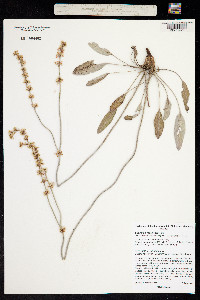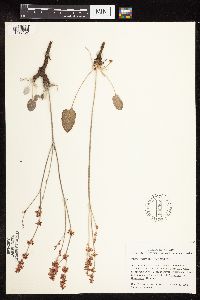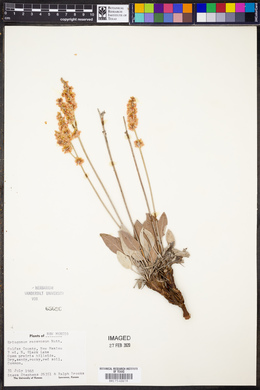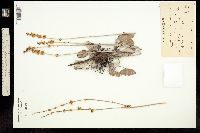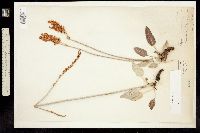Eriogonum racemosum
|
|
|
|
Family: Polygonaceae
Red-Root Wild Buckwheat, more...redroot buckwheat
[Eriogonum racemosum var. sagittatum] |
Herbs, erect to slightly spreading, 3-8(-10) × 0.5-1.5 dm, tomen-tose to floccose or rarely glabrous, grayish. Stems spread-ing to erect, without persistent leaf bases, up to 6 height of plant; caudex stems absent; aerial flowering stems erect to slightly spreading, slender to stout, solid, not fistulose, (1-)1.5-2.5(-3) dm, tomentose to floccose, rarely glabrous. Leaves basal, 1 per node; petiole (2-)3-10(-15) cm, tomentose to floccose; blade elliptic to ovate or oval to nearly rotund, (1.5-)2-6(-10) × 1-4(-5) cm, lanate to thinly tomentose abaxially, floccose or glabrous and green adaxially, margins plane. Inflorescences virgate or racemose with involucres racemosely disposed throughout or at tips, 15-50 × 05-20 cm, tomentose, rarely glabrous; branches dichotomous, upper secondaries suppressed and bearing 5-20(-30) racemosely arranged involucres; bracts 3, scalelike, triangular, and (1-)2.5-7 mm, or leaflike, linear-oblanceolate or oblanceolate to elliptic, and 10-40 × 5-20(-25) mm. Peduncles absent or erect, stout, 0.3-4 cm, tomentose to floccose. Involucres 1 per node, turbinate to turbinate-campanulate, (2-)3-5 × (2-)2.5-4 mm, tomentose to floccose; teeth 5, erect, (0.1-)0.2-0.5 mm. Flowers (2-)2.5-5 mm; perianth white to pinkish, glabrous; tepals connate proximal 4, monomorphic, oblong; stamens exserted, 2-5 mm; filaments pilose proximally. Achenes light brown, 3-4 mm, glabrous. 2n = 36. Flowering Jun-Oct. Sandy to gravelly flats and slopes, mixed grass, sagebrush, and mountain mahogany communities, scrub oak, pinyon, juniper, and conifer woodlands; 1400-2900(-3500) m; Ariz., Colo., Nev., N.Mex., Utah. Eriogonum racemosum is highly variable in stature, the presence of leaflike bracts in the inflorescences, the size and shape of the leaves, and the length of the mature flowers. None of these features is geographically correlated and thus no taxonomic distinctions are attempted. The species is occasionally cultivated. The tomentose, nonfistulose flowering stems easily distinguish it from Eriogonum zionis. Individuals of E. racemosum with glabrous flowering stems are known (Reveal & Holmgren 1893, BRY, US, UTC; Goodrich 17355, BRY; Neese & White 9237, BRY), but are rare and clearly aberrant expressions. The Navajo or Diné people use the roots of Eriogonum racemosum as a 'life medicine,' primarily in the treatment of internal problems, notably poisoning and diarrhea (C. Arnold, pers. comm.; P. A. Vestal 1952). They also use it as an analgesic and orthopedic aid (D. E. Moerman 1986; L. C. Wyman and S. K. Harris 1951); there are reports of its use for venereal disease. Leaves and stems were eaten raw by the Ramah Navajo in northwestern New Mexico (Wyman and Harris). Eriogonum racemosum is the food plant for the Spalding dotted-blue butterfly (Euphilotes spaldingi) and is occasionally visited by the desert green or Comstock's hairstreak (Callophrys comstocki).
Duration: Perennial Lifeform: Forb/Herb General: Perennial, 30-80 cm tall; plants evidently scapose; stems spreading to erect, tomentose, rarely glabrous; caudex woody. Leaves: Basal, alternate, elliptic, ovate, oval, or nearly round, mostly 2-6 cm long, 1-4 cm wide, bearing tufts of long, tangled hairs to glabrous above, whitish to grayish tomentose below, margins entire; petiole 2-15 cm long. Flowers: Inflorescence open, cyme-like, the branches villous; bracts of the inflorescence 3-8, somewhat leaf-like, 5-15 mm long; peduncles erect or nearly so, 1-7 cm long; involucre campanulate, 1-2 mm long, villous, teeth 5, erect to spreading; perianth 1-2 mm long, white, rose, or yellow, sometimes becoming reddish, the tepals dimorphic, the outer whorl oblong-ovate, the inner whorl linear- oblong; flowers July-October. Fruits: Achene, 3-4 mm long, light brown, not winged. Ecology: Grasslands, oak and pinyon-juniper woodlands, coniferous forests, often sandy to gravelly soils; 1200-2900 m (4000-9500 ft); Apache, Coconino, Gila, Maricopa, Mohave, Navajo, and Yavapai counties; southwestern U.S. Notes: This species is a host plant for Spalding-s blue and Acmon blue butterflies. The Navajo use it to treat backaches, and use the whole plant to make a cold tea for blood poisoning or internal injury. Leaves and stems are eaten raw. Editor: Springer et al. 2008 |
|
|
|




























